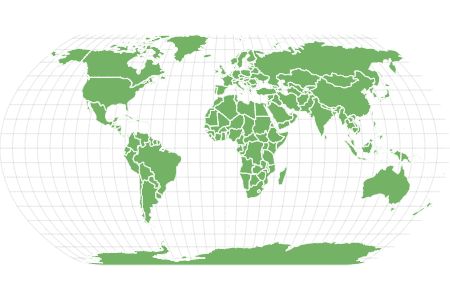Hermit Crab
Paguroidea
There are over 500 different species!
Advertisement
Hermit Crab Scientific Classification
- Kingdom
- Animalia
- Phylum
- Arthropoda
- Class
- Malacostraca
- Order
- Decapoda
- Family
- Paguroidea
- Scientific Name
- Paguroidea
Read our Complete Guide to Classification of Animals.
Hermit Crab Conservation Status
Hermit Crab Facts
- Main Prey
- Fish, Worms, Plankton
- Habitat
- Coastal waters
- Predators
- Fish, Sharks, Cuttlefish
- Diet
- Omnivore
- Average Litter Size
- 200
- Favorite Food
- Fish
- Common Name
- Hermit Crab
- Number Of Species
- 500
- Location
- Worldwide
- Slogan
- There are over 500 different species!
View all of the Hermit Crab images!
Hermit Crab Summary
Hermit crabs are small crustaceans that live in shallow waters around the world. Contrary to their common name, hermit crabs are not solitary creatures but frequently live in communities of 100 or more. These crustaceans get their name from the mollusk shells that they carry on their backs and must periodically swap out as they grow. Hermit crabs need these appropriate shells as, unlike other crustaceans, they have soft bodies and only have hard exoskeletons for the front part of their bodies.
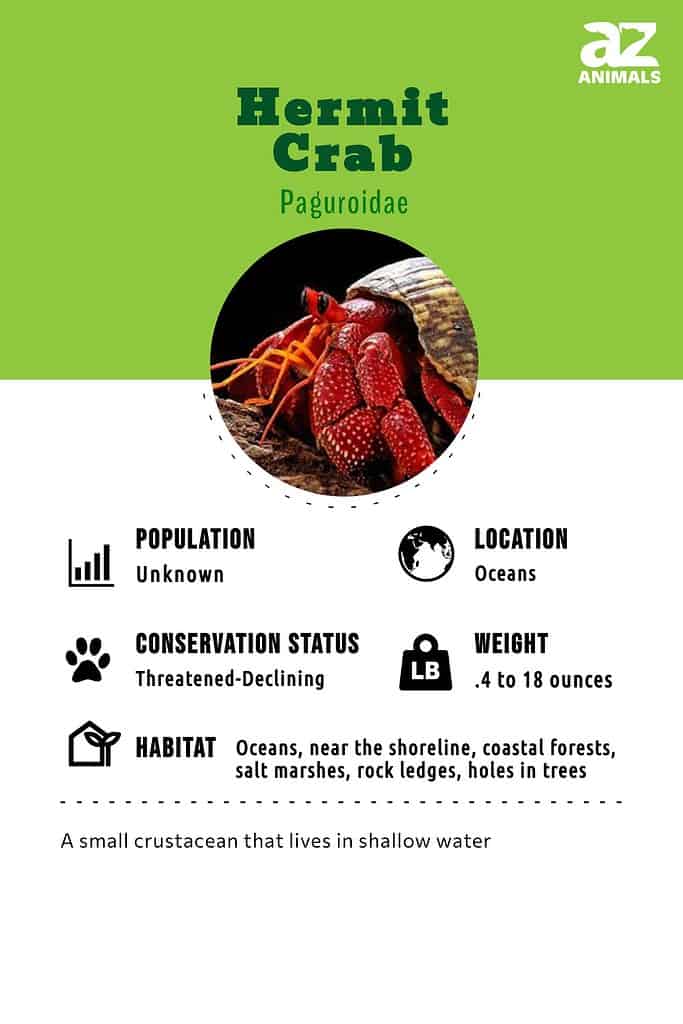
Five Fun Facts
- There are more than 1,100 hermit crab species worldwide
- Hermit crabs do not breed in captivity; thus, all that are sold as pets have been harvested from the wild
- Some crabs eat their soft molted shells to get vitamins, minerals, and calcium
- When selecting a new shell, a hermit crab will inspect it visually and physically before deciding to move in
- Competition for shells can be fierce and often results in fights between two crabs to secure a prime shell
You can check out more incredible facts about hermit crabs.
Scientific Name
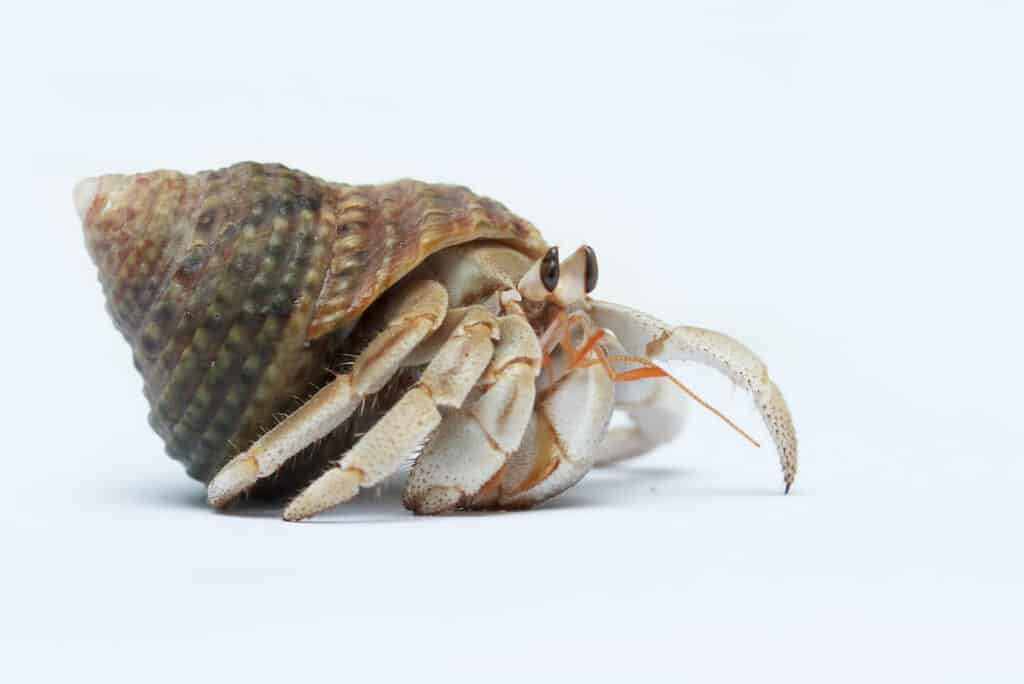
The scientific name for a hermit crab is Paguroidea.
©Wow Pho/Shutterstock.com
The scientific name for hermit crabs is Paguroidea, representing a superfamily of decapod crustaceans that have a soft asymmetrical abdomen and occupy empty shells of other mollusks. The taxonomy of Paguroidea is further organized into seven subfamilies that represent both land and marine species.
Evolution
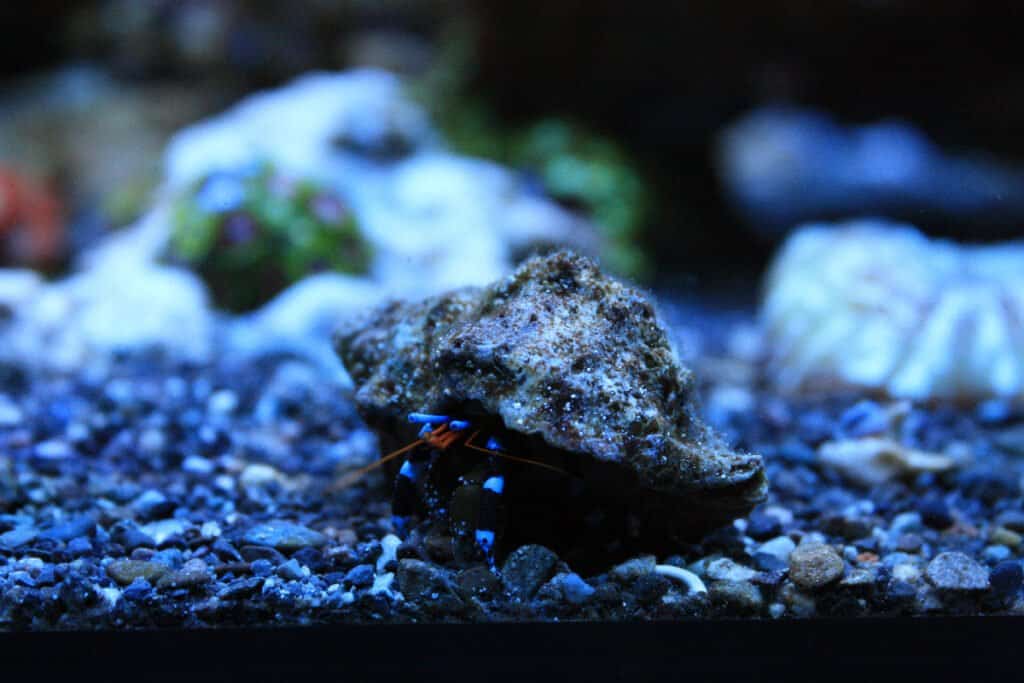
Elegant hermit crabs can reach three inches or more
©Dream Reef/Shutterstock.com
The hermit crab is a unique species of crustacean that has evolved over millions of years. It belongs to the family Paguridae and can be found in oceans all around the world. Hermit crabs have adapted to their environment by carrying their own home with them, where they are able to hide from predators or seek shelter when needed.
Hermit crabs first appeared during the Cambrian period, approximately 540 million years ago, but it wasn’t until much later (the Jurassic period) that they began using gastropod shells as homes. This allowed them to survive better in their environment since these shells provided strong protection against predators and harsh environmental conditions such as temperature changes.
Over time, different species of hermit crab emerged due to selective pressures caused by changing climates and habitats, which led to adaptations such as varying shell sizes and shapes depending on what type of habitat they inhabited. These variations made it possible for some hermit crabs to live in deeper waters, while others preferred shallow areas close to shorelines.
Today there are hundreds of species of hermit crab worldwide. However, despite this diversity, most still rely on gastropod shells for protection and shelter, just like their ancient ancestors did millions of years ago!
Appearance and Behavior
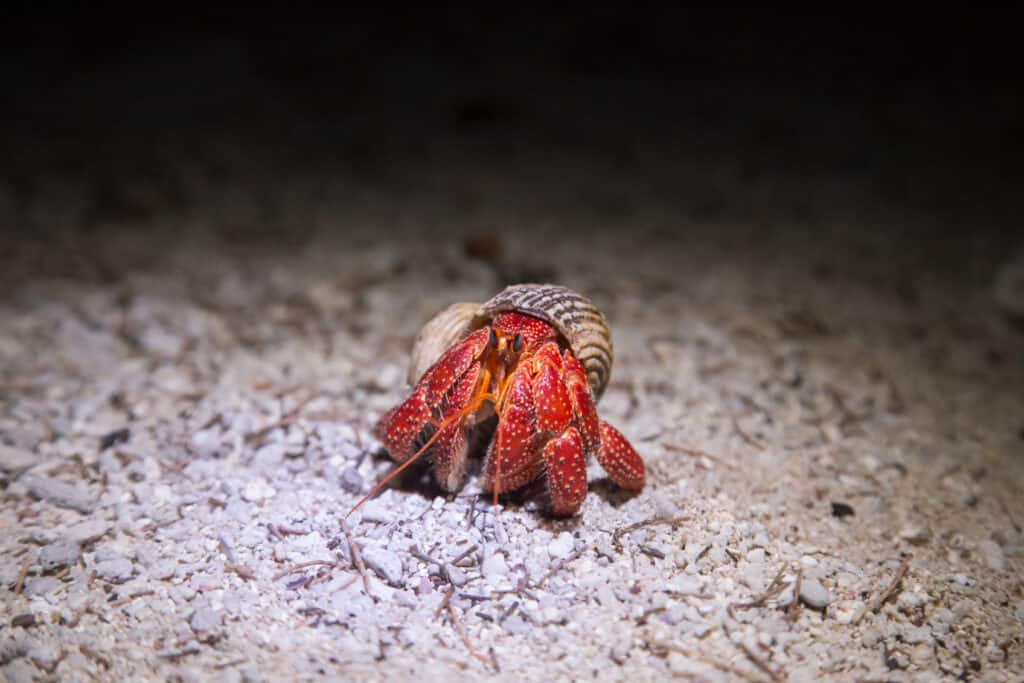
Strawberry hermit crabs are nocturnal.
©Oliver Foerstner/Shutterstock.com
Because hermit crabs encompass so many different species, they generally range in size from about a half-inch to over four inches in length. A few exotic species grow to 11 inches. You can also find them in many different colors, including green, red, blue, yellow, orange, brown, pink, and white.
A hard exoskeleton covers the front half of the hermit crab’s body, like that of other crabs. Where hermit crabs differ is that they have long, sometimes twisted, abdomens that are soft and can fit into a discarded shell. As hermit crabs grow, they need to find larger shells to accommodate growth.
Hermit crabs molt when they grow, building up water inside their bodies to split the old shells. Some species will leave their shell and bury themselves in the sand to molt, while others remain in their shell and only emerge right before molting. The process takes 45 to 120 days. Newly molted crabs are blue. To fit inside a shell, a hermit crab presses its abdomen, its fourth and fifth pairs of legs, and its uropods against the shell’s inner wall.
Land and marine hermit crabs have gills with highly vascular areas for oxygen exchange. Land crabs keep their gills moist by storing water in their bodies. Their eyes are atop stalks, and their heads have two pairs of antennae. They use the longer ones for feeling and the shorter pair for tasting and smelling. The antennae are also vibration sensors. The first pair of legs is a set of pincers, with one side larger than the other. Hermit crabs walk on their second and third set of legs.
The largest hermit crabs in the world
The largest species of hermit crab is the coconut crab, a species that can grow to 40 inches in length! The coconut crab is an outlier in terms of size, but other species can grow much larger than average hermit crabs. The giant red hermit crab is a marine crab that can reach 12 inches in length. They live off the Eastern Seaboard of the United States.
Habitat
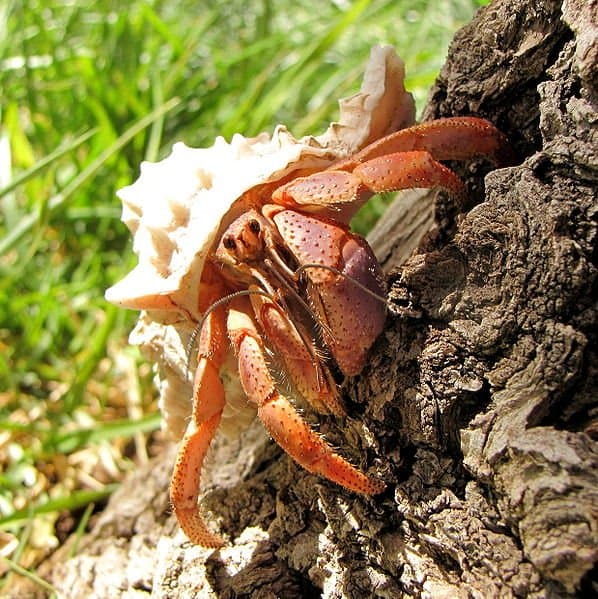
Hermit crabs hide from predators under rocks and in the holes of trees.
Whether a land or marine species, hermit crabs are usually found near the shoreline because of abundant food and places to hide. Land crabs use pools of seawater to wet the interior of their shells and their gills. They also use these pools for reproduction. Semi-terrestrial specials live in tubes or plant stems, sections of bamboo, and broken coconut shells in addition to seashells. Habitats can include coastal forests and salt marshes. You’ll often find them hiding under vegetation, under rock ledges, and in holes in trees where predators can’t find them.
Aquatic species live in sandy- or muddy-bottomed environments and occasionally venture out into deeper water. Pyloches, a species that lives in the Indian Ocean, can be found at depths of 600 to 1,200 feet, where it lives in hollow wood. Other species live inside coral or sponges. Some species, such as Pagurus bernhardus, a red crab found in North American and European waters, often live with anemones on its shell.
Diet
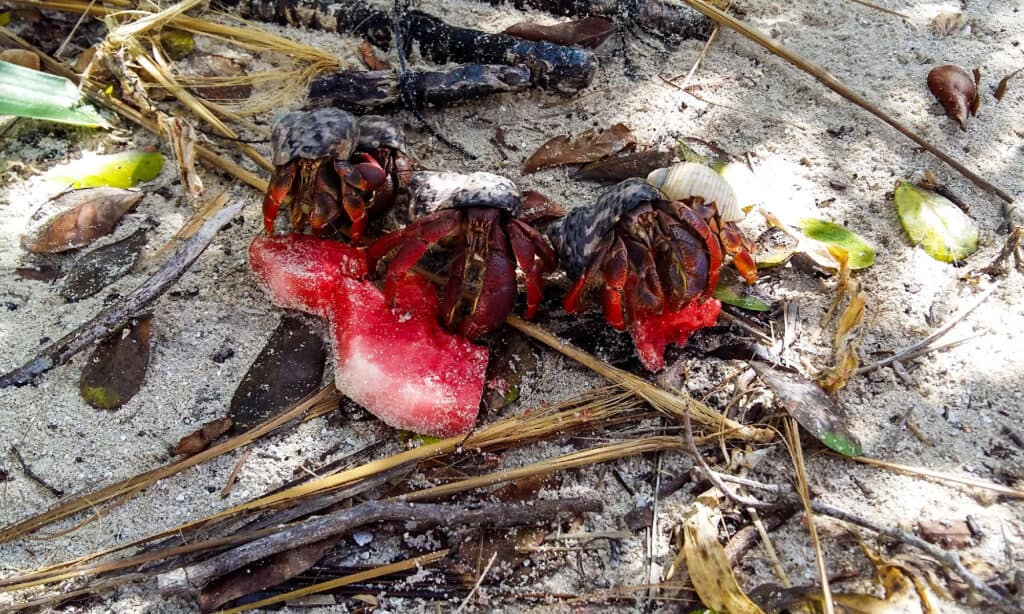
Hermit crabs are scavenging omnivores that eat plants and animals.
©Katrin85/Shutterstock.com
All species of hermit crabs are active in their quest for food, usually moving about at night. They are foragers, meaning that they are omnivores and eat a variety of detritus that other creatures won’t eat. They play an essential role in the benthic or bottom-dwelling marine community by cleansing the environment. Their favorite food consists of small fish and invertebrates, such as worms, along with plankton and other similar particles in the water. They will even consume dead hermit crabs if given a chance.
Predators and Threats
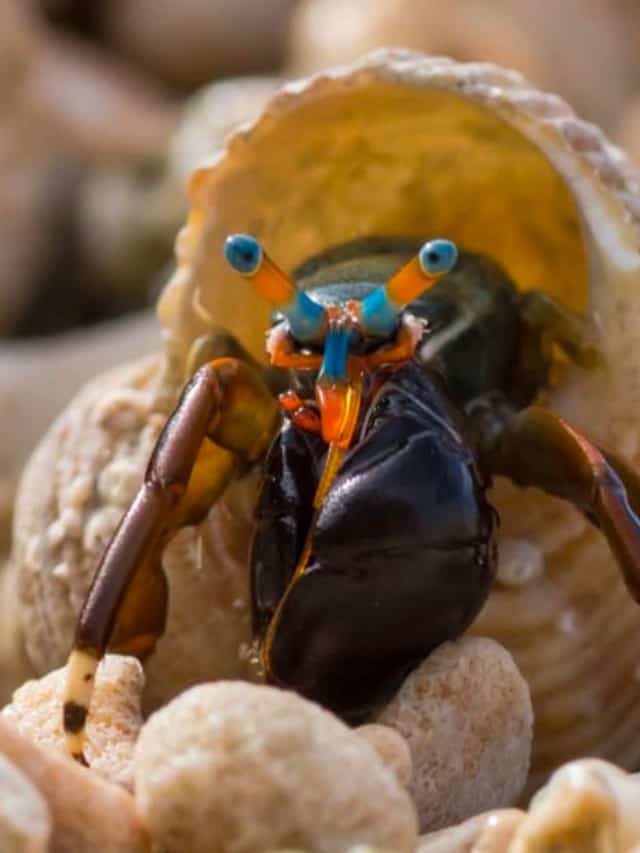
Hermit crabs have to watch out for sharks and octopuses.
©Chase Clausen/Shutterstock.com
The small size of most hermit crabs makes them vulnerable to many different predators, including sharks, many different fish species, cuttlefish, squid, and octopus. Although fisheries don’t target these crabs for food, they often get caught up when fisheries try to trap other types of seafood.
Conservation
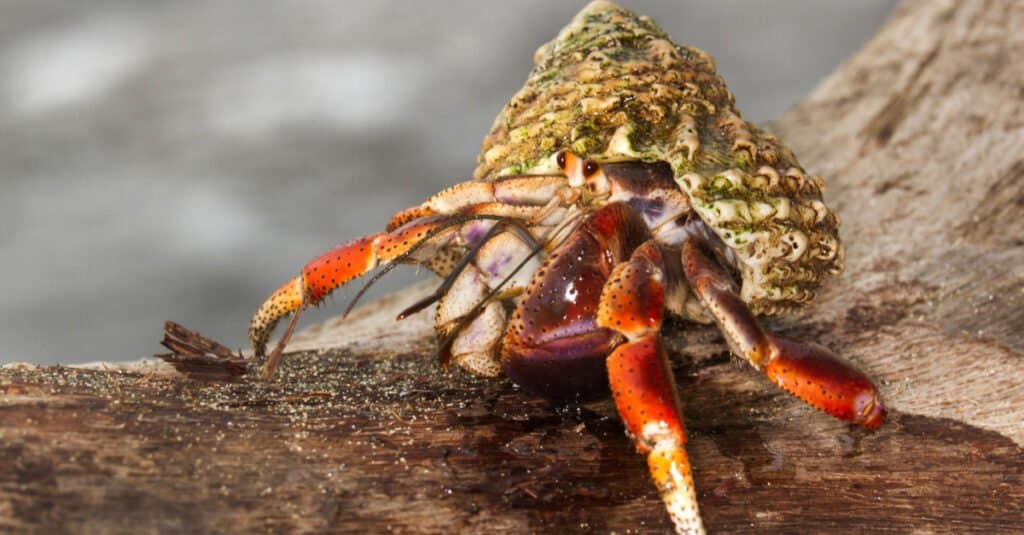
The pet trade harvests wild hermit crabs, which is harmful to the ecosystem.
©Natalia Kuzmina/Shutterstock.com
Hermit crabs are one of the most interesting and unique creatures that inhabit our planet. Unfortunately, their conservation status is not as well known or cared for as it should be. Hermit crabs face a variety of threats in their natural habitat, including habitat destruction due to human activities such as coastal development and pollution from plastic garbage entering the ocean. In addition, many hermit crab species are being threatened by overfishing, climate change, and disease outbreaks caused by pathogens introduced by humans.
It is unethical to keep a hermit crab as a pet because the pet trade is harvesting wild hermit crabs, which is drastically reducing their populations. It can be dangerous for wild populations and the delicate balance of the ecosystem as a whole when people collect them from the wild instead of buying captive-bred specimens from reputable breeders – this practice disrupts local ecosystems and increases pressure on already limited resources available in nature.
Reproduction, Babies, and Lifespan

Hermit Crabs need shallow sea water to mate and reproduce.
Hermit crabs need seawater to reproduce, which is why land crabs head to shallow waters to mate. Both males and females need to emerge partially from their borrowed shells to reproduce. Mating occurs once a year. The male holds the female with one claw, pulling her back and forth while stroking her to fertilize her. Each female has abdominal appendages that allow her to carry the eggs until they are ready to hatch. Incubation is approximately one month. The females must be in the water to release the eggs, which turn into swimming larvae called zoea upon release. These larvae live like plankton for a time until finally descending to the seafloor. Zoea grows and molts several times to become megalops and then grows and molts into juveniles, eventually reaching the stage where they must find their shells. Terrestrial species of hermit crabs only return to land when they are adults. Younger hermit crabs molt every few months, while older ones may not molt for as long as 18 months.
Most hermit crabs have an average lifespan of one to 10 years. Some species, however, can live for as long as 30 years. One land species, the Coenobita brevimanus can live as long as 70 years.
Population
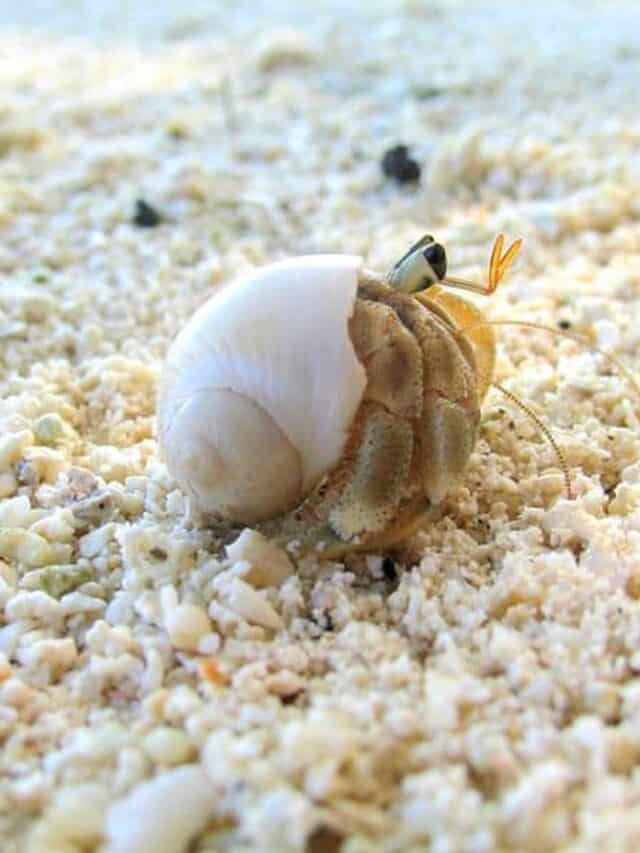
Hermit Crabs should not be kept as pets.
©www.viajar24h.com / CC BY 2.0 – License
Hermit crabs are found all over the world in tropical and sub-tropical waters as well as in many temperate zones in the northern hemisphere. They are not considered endangered, although the condition of many of their habitats threatens their survival. In some places, hermit crabs are beginning to mistake plastic containers for shells, which is further threatening their survival. The number of these animals worldwide is unknown.
Even though hermit crabs make interesting pets, they are not recommended for beginners. Furthermore, many animal rights groups recommend not buying them as all hermit crabs sold in pet stores have been harvested from the wild. The painted shells that the crabs are often sold with are slowly poisoning the animal. This practice of keeping them as pets is unsustainable as hermit crabs do not breed in captivity. Therefore, keeping these animals as pets is inadvisable.
37 Types of Hermit Crabs
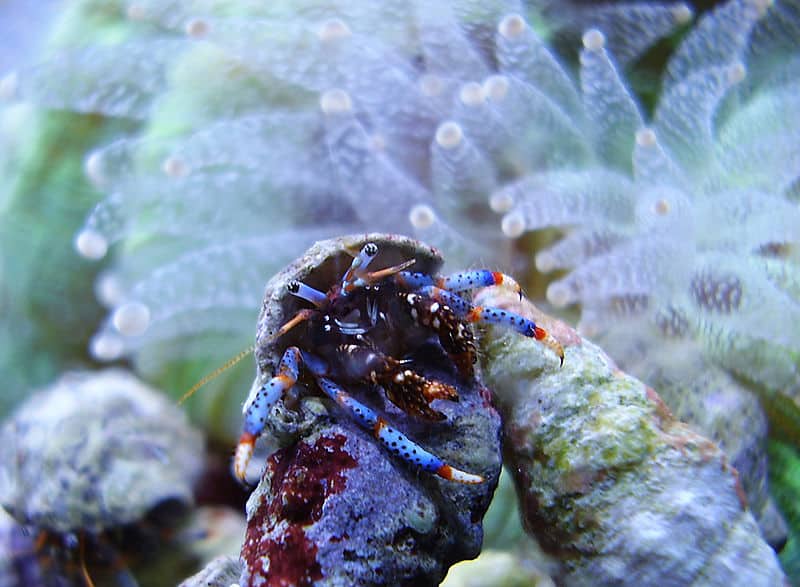
There are 1,200 different species of hermit crabs in the world!
There are 120 different genera of hermit crabs, spanning 1,200 species!
- Strawberry Hermit Crab – Coenobita perlatus
- Long-Wristed Hermit Crab – Pagurus longicarpus
- Giant Hermit Crab – Petrochirus diogenes
- Land Hermit Crab – Coenobita rugosus
- Passionfruit Hermit Crab – Coenobita cavipes
- Komurasaki Hermit Crab – Coenobita violascens
- Thinstripe Hermit Crab – Clibanarius vittatus
- Blueband Hermit Crab – Pagurus samuelis
- Red Reef Hermit Crab – Dardaus arrosor
- South-claw Hermit Crab – Diogenes pugilator
- Orange Claw Hermit Crab – Calcinus tibicen
- Green Clinging Crab – Mithraculus sculptus
- Blue Line Hermit Crab – Calcinus elegans
- Caribbean Hermit Crab – Coenobita clypeatus
- Australian Land Hermit Crab – Coenobita variabilis
- Common Hermit Crab – Pagurus bernhardus
- Blueberry Hermit Crab – Coenobita Purpureus
- Red Hermit Crab – Dardanus calidus
- Freshwater Hermit Crab – Clibanarius fonticola
- Polka Dot Hermit Crab – Phimochirus operculatus
- Striated Hermit Crab – Clibanarius erythropus
- Blue-legged Reef Hermit Crab – Clibanarius tricolor
- Lila Hermit Crab – Coenobita lila
- Orange-striped Hermit Crab – Clibanarius infraspinatus
- Ecuadorian Hermit Crab – Coenobita compressus
- Coconut Crab – Birgus latro
- Indo Land Hermit Crab – Coenobita Brevimanus
- Brown Hermit Crab – Coenobita cavipes
- Halloween Hermit Crab – Ciliopagurus strigatus
- Dwarf Zebra Hermit Crab – Calcinus Laevimanus
- Scarlet Hermit Crab – Paguristes cadenati
- Broad-clawed Hermit Crab – Pagurus pollicaris
- Banded Hermit Crab – Pagurus annulipes
- Eye-spot Hermit Crab – Paguristes eremita
- Forest Hermit Crab – Coenobita spinosus
- Red Land Hermit Crab – Coenobita rubescens
- Marble Land Hermit Crab – Coenobita pseudorugosu
Hermit Crab FAQs (Frequently Asked Questions)
Why is one pincer larger than the other?
The larger pincer serves as a protective door when the crab retreats inside its shell.
Are hermit crabs true crabs?
Although they are crustaceans, hermit crabs are more closely related to lobsters.
Can you pull a hermit crab out of its shell?
It’s nearly impossible to do so because the crab wraps its abdomen tightly around the shell’s interior while also holding on tightly with one of its uropods.
Why do hermit crabs fight over shells?
Good shells are at a premium for these crabs. As they grow, hermit crabs need bigger shells, so they often steal shells when someone in their community is molting.
Can hermit crabs grow smaller?
If they find themselves in a shell that is too small, hermit crabs have the rare ability to grow smaller.
What is a "vacancy chain?"
To avoid fights over shells, hermit crabs looking for new ones will sometimes line up in order of size to enter a new home as larger crabs vacate their old ones.
Are Hermit Crabs herbivores, carnivores, or omnivores?
Hermit Crabs are Omnivores, meaning they eat both plants and other animals.
What Kingdom do Hermit Crabs belong to?
Hermit Crabs belong to the Kingdom Animalia.
What phylum do Hermit Crabs belong to?
Hermit Crabs belong to the phylum Arthropoda.
What class do Hermit Crabs belong to?
Hermit Crabs belong to the class Malacostraca.
What family do Hermit Crabs belong to?
Hermit Crabs belong to the family Paguroidea.
What order do Hermit Crabs belong to?
Hermit Crabs belong to the order Decapoda.
What type of covering do Hermit Crabs have?
Hermit Crabs are covered in Shells.
Where do Hermit Crabs live?
Hermit Crabs are found worldwide.
In what type of habitat do Hermit Crabs live?
Hermit Crabs live in coastal waters.
What is the main prey for Hermit Crabs?
Hermit Crabs prey on fish, worms, and plankton.
What are some predators of Hermit Crabs?
Predators of Hermit Crabs include fish, sharks, and cuttlefish.
What is the average litter size for a Hermit Crab?
The average litter size for a Hermit Crab is 200.
What is an interesting fact about Hermit Crabs?
There are over 500 different Hermit Crab species!
What is the scientific name for the Hermit Crab?
The scientific name for the Hermit Crab is Paguroidea.
How many species of Hermit Crab are there?
There are 500 species of Hermit Crab.
How do Hermit Crabs have babies?
Hermit Crabs lay eggs.
What is the difference between male and female hermit crabs?
Scientifically known as Paguroidea, male and female hermit crabs have a few differences ranging from sexual organs to certain physical characteristics and mating behaviors that can help decipher their rather hard-to-tell sexes.
Thank you for reading! Have some feedback for us? Contact the AZ Animals editorial team.
Sources
- David Burnie, Dorling Kindersley (2011) Animal, The Definitive Visual Guide To The World's Wildlife
- Tom Jackson, Lorenz Books (2007) The World Encyclopedia Of Animals
- David Burnie, Kingfisher (2011) The Kingfisher Animal Encyclopedia
- Richard Mackay, University of California Press (2009) The Atlas Of Endangered Species
- David Burnie, Dorling Kindersley (2008) Illustrated Encyclopedia Of Animals
- Dorling Kindersley (2006) Dorling Kindersley Encyclopedia Of Animals

